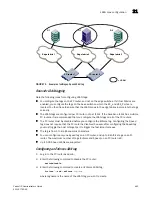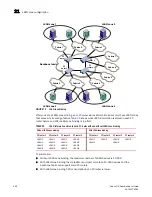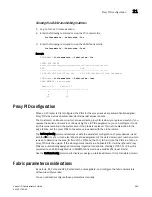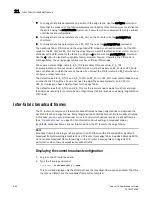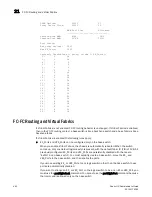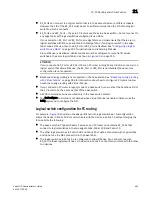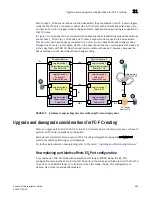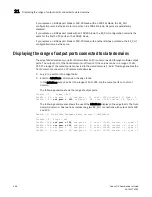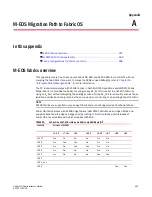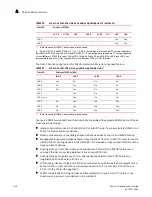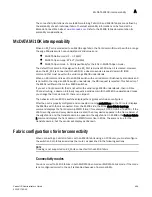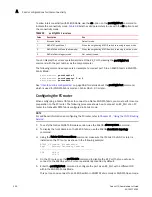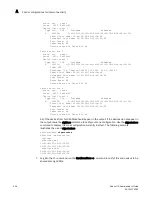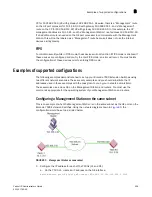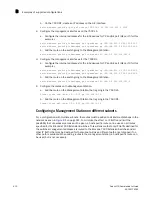
Fabric OS Administrator’s Guide
495
53-1001763-02
Upgrade and downgrade considerations for FC-FC routing
21
Even though F_Ports are not allowed in the base switch, they are allowed in an FC router in legacy
mode (Fabric OS v6.1.x or earlier, or Fabric OS v6.2.0 or later with Virtual Fabrics disabled). If you
connect an FC router in legacy mode to the base switch, backbone-to-edge routing is supported on
that FC router.
In
Figure 76
, no devices can be connected to the backbone fabric (Fabric 8) because base switches
cannot have F_Ports.
Figure 78
shows an FC router in legacy mode connected to a base switch.
This FC router
can
have devices connected to it, and so you can have backbone-to-edge routing
through this FC router. In this figure, Host A in the backbone fabric can communicate with device B
in the edge fabric with FID 20; Host A cannot communicate with device C, however, because the
base switches do not support backbone-to-edge routing.
FIGURE 78
Backbone-to-edge routing across base switch using FC router in legacy mode
Upgrade and downgrade considerations for FC-FC routing
When you upgrade to Fabric OS v6.4.0 or later, EX_Ports remain functional and you can continue to
perform all FC router operations on the switch.
Brocade recommends that you save your FC-FC routing configuration (using the configUpload
command) before performing any downgrades.
For further instructions on downgrading, refer to
Chapter 9, “Installing and Maintaining Firmware”
.
How replacing port blades affects EX_Port configuration
If you replace an FR4-18i blade with an 8-Gbps port blade or FX8-24 blade, the EX_Port
configuration remains the same for the first 16 ports on the 8-Gbps port blade (and for the first 12
FC ports on the FX8-24 blade). For all other ports on the blade, the EX_Port configuration is
cleared. No ports are persistently disabled.
Logical switch 8
(Base switch)
Fabric ID 8
Logical switch 7
Fabric ID 15
Logical switch 6
Fabric ID 1
Allows XISL use
Logical switch 5
(Default logical switch)
Fabric ID 128
Physical chassis 2
Logical switch 4
(Base switch)
Fabric ID 8
E
Logical switch 3
Fabric ID 15
E
Logical switch 2
Fabric ID 1
Allows XISL use
E
Logical switch 1
(Default logical switch)
Fabric ID 128
E
Physical chassis 1
E
E
E
XISL
EX
EX
F
F
E
IFL
IFL
ISL
ISL
E
ISL
FC router
Fabric ID 4
E
EX
IFL
A
B
C
Edge fabric
FID 20
E
Summary of Contents for 53-1001763-02
Page 1: ...53 1001763 02 13 September 2010 Fabric OS Administrator s Guide Supporting Fabric OS v6 4 0 ...
Page 4: ...iv Fabric OS Administrator s Guide 53 1001763 02 ...
Page 24: ...xxiv Fabric OS Administrator s Guide 53 1001763 02 ...
Page 28: ...xxviii Fabric OS Administrator s Guide 53 1001763 02 ...
Page 32: ...xxxii Fabric OS Administrator s Guide 53 1001763 02 ...
Page 40: ...xl Fabric OS Administrator s Guide 53 1001763 02 ...
Page 42: ...2 Fabric OS Administrator s Guide 53 1001763 02 ...
Page 54: ...14 Fabric OS Administrator s Guide 53 1001763 02 High availability of daemon processes 1 ...
Page 74: ...34 Fabric OS Administrator s Guide 53 1001763 02 Basic connections 2 ...
Page 102: ...62 Fabric OS Administrator s Guide 53 1001763 02 Audit log configuration 3 ...
Page 214: ...174 Fabric OS Administrator s Guide 53 1001763 02 Management interface security 7 ...
Page 228: ...188 Fabric OS Administrator s Guide 53 1001763 02 Brocade configuration form 8 ...
Page 276: ...236 Fabric OS Administrator s Guide 53 1001763 02 Creating a logical fabric using XISLs 10 ...
Page 404: ...364 Fabric OS Administrator s Guide 53 1001763 02 ...
Page 440: ...400 Fabric OS Administrator s Guide 53 1001763 02 Performance data collection 17 ...
Page 480: ...440 Fabric OS Administrator s Guide 53 1001763 02 F_Port masterless trunking 19 ...
Page 494: ...454 Fabric OS Administrator s Guide 53 1001763 02 Buffer credit recovery 20 ...
Page 574: ...534 Fabric OS Administrator s Guide 53 1001763 02 Hexadecimal overview E ...



